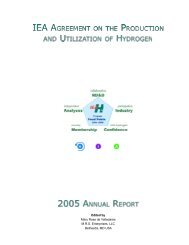Technology Status of Hydrogen Road Vehicles
Technology Status of Hydrogen Road Vehicles
Technology Status of Hydrogen Road Vehicles
Create successful ePaper yourself
Turn your PDF publications into a flip-book with our unique Google optimized e-Paper software.
During the past 5 years, a carbon sorption technique in the pressure vessel has allowed both the mass and<br />
volume densities to be almost doubled, depending on the bulk hydrogen pressure. Unfortunately, the effect<br />
seems to be most marked at pressures lower than 70 bar (Hynek et al. 1994).<br />
Zeolites (aluminosilicates) may be a promising way <strong>of</strong> allowing more hydrogen to be held within a given<br />
volume. Querubin et al. (1994) states that zeolites, whose bulk density is about 10 times that <strong>of</strong> activated<br />
carbon, are expected to be about four times better for hydrogen storage on a unit volume basis. A similar line<br />
is represented by micro-encapsulation <strong>of</strong> hydrogen in glass. Duret and Saudin (1992) in France and Akunets<br />
et al. (1992) in Russia have investigated this. Both achieved improved weight density.<br />
Griesinger et al. (1996) treat ongoing basic work on zeolites, and mention the possibility <strong>of</strong> new synthetic<br />
zeolites with improved storage capability.<br />
No figures are available that predict the results <strong>of</strong> these various lines <strong>of</strong> research. The research will continue,<br />
however, because, at high pressures and with improved sorption techniques, GH 2 systems (at liquid nitrogen<br />
temperatures) may approach those for LH 2 on a mass and volume density basis.<br />
Ewald (1996) states, however, that there is little point in using pressures higher than 300 bar because the<br />
supply infrastructure becomes quite difficult, and the filling factor decreases because <strong>of</strong> non-ideal gas<br />
behavior.<br />
Compared to LH 2 or MH, refilling simple GH 2 vehicles is rather straightforward if a bulk storage vessel with<br />
the necessary pressure difference is available. Open-air, well-ventilated stations are required, and the level<br />
<strong>of</strong> personnel expertise is not too high. A vehicle can probably be refilled in several minutes, but little<br />
information is available.<br />
3.2 Metal Hydrides<br />
Metal hydrides are formed when hydrogen is added under modest pressure to suitable alloys in an exothermic<br />
reaction that seems simple to control:<br />
e.g. FeTi + H 2 FeTiH 2 + heat + 25% volume increase<br />
The GH 2 is recovered by adding heat, in this case at a modest temperature <strong>of</strong> 70 o C, which could easily be<br />
supplied by the exhaust heat or cooling water <strong>of</strong> the prime mover. Startup requires supplementary measures.<br />
The metals <strong>of</strong> interest (the most common after Fe, Ti being Mg, Ni, Mn, etc.), although not as rare as some<br />
catalysts they resemble, can probably experience decomposition and pulverization over a limited life, and rapid<br />
loss <strong>of</strong> their storage capabilities. This may be the only way <strong>of</strong> storing hydrogen so it cannot escape in bulk<br />
during an accident or operational leaks and vents. Heat must be deliberately added to release the hydrogen,<br />
and the system never has more free hydrogen than required for immediate needs.<br />
So this great advantage decreases as the other storage systems reach excellent standards <strong>of</strong> containment. Still,<br />
it explains the favor bestowed on it for early, startup research and development and for some prototypes. It<br />
is, however, almost the only advantage. Its major drawback is poor energy density on a weight basis, which<br />
is about half that <strong>of</strong> 300 bar GH 2. Even though on a volume basis it can outperform GH 2 (though not LH 2)<br />
the weight penalty so far is severe in mobile applications. However, interest remains high, and much work<br />
is underway to unearth the metal combinations that could reduce the weight penalty to manageable proportions<br />
and maintain structural integrity under repeated cycling over many years. Related fields <strong>of</strong> powder metallurgy<br />
and catalysts may provide unexpected inputs.<br />
5













